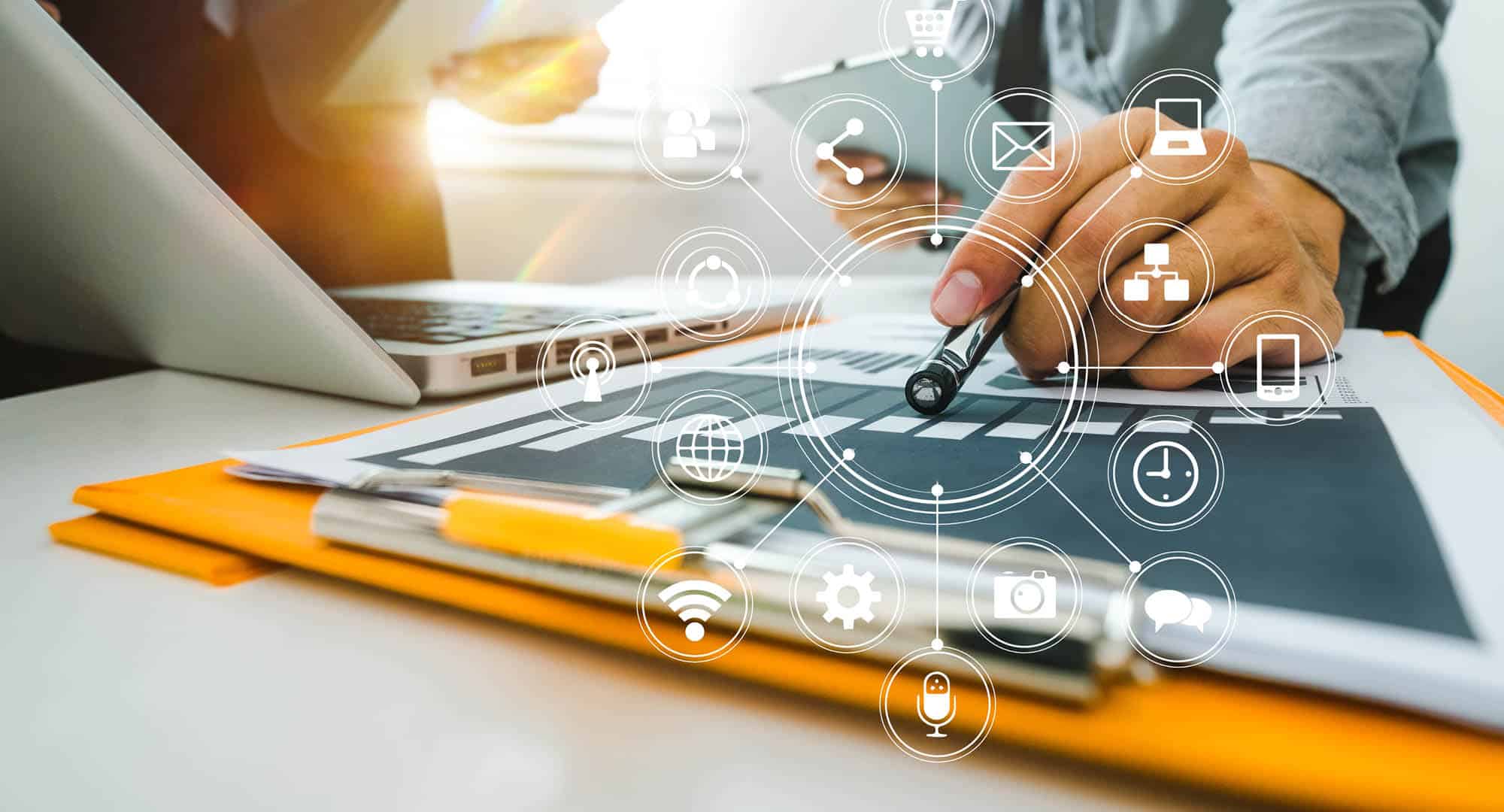Disaster Almost Strikes in Linkedin
The £890 LinkedIn Boost Blunder!
For the first time, I decided to boost a LinkedIn post. Thinking I had set a modest £25 budget, I was shocked when I checked the campaign a day later – it had already racked up a staggering £890 spend… and was still running! Arghh!
This was an emergency. I needed help, and I needed it fast.
I immediately reached out to Nigel, who responded quickly. After expressing his sympathy for my unplanned expense, he got straight to work. Not only did he help me understand what had gone wrong, but he also turned the situation into a valuable learning opportunity.

Advanced LinkedIn Strategy Consultation
Since our business already had a strong LinkedIn foundation, Nigel provided an advanced LinkedIn strategy consultation that went beyond just fixing my advertising mistake. He helped us reassess and refine our LinkedIn approach for upcoming initiatives – especially as we prepare to scale Cranston Engineering with our trademarked HADA AI product.
Before our one-hour masterclass session, Nigel took the initiative to review our LinkedIn presence thoroughly:
✅ My personal LinkedIn profile
✅ Cranston Engineering’s company page
✅ My colleague Veronica’s LinkedIn profile
During our session, Nigel walked us through each profile step by step, offering:
Honest, constructive feedback on areas for improvement
Profile optimisation strategies to enhance visibility and engagement
Content strategy recommendations tailored to meet our business goals
Event promotion best practices, ensuring we maximise LinkedIn’s potential for our upcoming exhibitions
Engagement tactics to build meaningful relationships and grow our audience
What truly stood out was Nigel’s clarity, precision, and actionable advice. No fluff – just practical steps that could be implemented immediately.
Post-Session Support & Clear Next Steps
Within hours of our meeting, Nigel provided us with a concise, well-structured summary of everything we had covered, along with:
📌 A personalised roadmap for profile optimization
📌 A LinkedIn content and engagement strategy
📌 A detailed event promotion checklist, including pre-event, during-event, and post-event actions. In fact, over thirty refined tips!
This was next-level LinkedIn coaching. Not just theory, but real-world strategies that align with our business growth plans.
Final Thoughts: Why Nigel Cliffe is a Must-Have LinkedIn Expert
I can confidently say that Nigel delivers.
His deep expertise, tailored approach, and ability to provide immediate value make him an outstanding LinkedIn trainer and strategist.
From foundational LinkedIn training to advanced strategy consulting and crisis management, Nigel is the person you want in your corner.
We will undoubtedly continue working with Nigel to fine-tune our LinkedIn presence and business strategy. Our “LinkedIn shop window” is now shinier than ever, and with his guidance, it will only get better.
If you’re serious about LinkedIn success, whether as an individual or a business, look no further than Nigel.
Agile Alliance Joins Project Management Institute (PMI)
Agile Alliance Joins Project Management Institute (PMI)
The agreement marks the beginning of a new phase of global development for Agile Alliance, now operating as PMI Agile Alliance. Together, PMI and PMI Agile Alliance, global leaders in the project and Agile communities create greater opportunities for professionals worldwide to maximize the value delivered through projects, product delivery, and transformations.

3 January 2024 — Project Management Institute (PMI), the world’s leading authority for project management professionals, signed an agreement on 31 December 2024 through which Agile Alliance® joins PMI. Agile Alliance is a global non-profit membership organization founded in 2001 by some of the original authors of the Manifesto for Agile Software Development.
This partnership strengthens the project management profession by expanding access to Agile resources, broadening skill sets, and fostering a flexible mindset.
Both organizations are committed to ensuring a seamless transition. As part of this process, Teresa Foster, Managing Director of Agile Alliance, and her team will transfer to PMI. PMI Agile Alliance will maintain its membership structure and elected Board, continuing its core mission and values while championing agility and the values and principles of the manifesto. Agile Alliance members will retain access to the resources, events, and connections they value, now augmented by PMI’s expanded opportunities. PMI members, in turn, will benefit from Agile Alliance’s community-generated resources, fostering new connections, learning, and collaboration to drive innovation.
Modern project delivery demands fluency across a continuum of delivery practices, enabling professionals to choose the right approach for each project. Successful delivery requires a combination of skills and knowledge tailored to specific contexts.
The future of project management—centered on project success driven by delivered value—cannot rely on rigid distinctions between delivery approaches. The integration of Agile Alliance within PMI further solidifies PMI’s leadership in transforming the project profession. PMI Agile Alliance will benefit from PMI’s global reach and resources, while PMI members will gain expanded access to Agile thought leadership, tools, and resources, enhancing their professional development and enabling greater project success.
“We believe successful projects are the key to changing the world. The Agile movement has significantly influenced project management and product development, with its principles extending well beyond the Tech industry and software development.”
– Pierre Le Manh, PMP, President & CEO of PMI
“We believe successful projects are the key to changing the world. The Agile movement has significantly influenced project management and product development, with its principles extending well beyond the Tech industry and software development,” said Pierre Le Manh, PMP, President & CEO of PMI. “Proper project management requires mastery of multiple approaches that can be combined according to the context. PMI and Agile Alliance have collaborated for several years, including on the Agile Practice Guide. As Agile Alliance sought ways to increase its global impact, PMI was a natural partner in providing the resources needed for this new phase of development. Together, we will broaden the understanding of Agile and agility, inspire diverse thinking, and empower the profession to achieve greater project success.”
Building on this shared vision, Foster adds, “Our mission has always been to advance Agile as a mindset and spread Agile principles and values. By joining forces with PMI, we’re expanding our ability to support practitioners, create new resources, and foster a more flexible and innovative community.”
“By joining forces with PMI, we’re expanding our ability to support practitioners, create new resources, and foster a more flexible and innovative community.”
– Teresa Foster, Managing Director of Agile Alliance
This agreement builds on a long-standing relationship between PMI and Agile Alliance, which includes their collaboration on the Agile Practice Guide—a publication offering tools, situational guidelines, and insights into various Agile approaches.
About PMI
PMI is the leading authority in project management, dedicated to guiding the way to project success. Since 1969, PMI has shone a light on the power of project management and the people behind the projects. With a global community, gold-standard professional certifications, and career-long learning opportunities, PMI empowers current and aspiring project professionals, as well as organizations, with knowledge and resources to lead effectively and create an impact in the communities they serve. Join PMI in elevating our world – one project at a time. Connect with PMI at www.pmi.org, and on LinkedIn, Instagram, and TikTok.
About Agile Alliance
Agile Alliance is a nonprofit organization with global membership, supporting and serving the Agile community since 2001. Agile Alliance supports people who explore and apply Agile values, principles, and practices to make building solutions more effective, humane, and sustainable.
Emotional Intelligence by Daniel Goldman
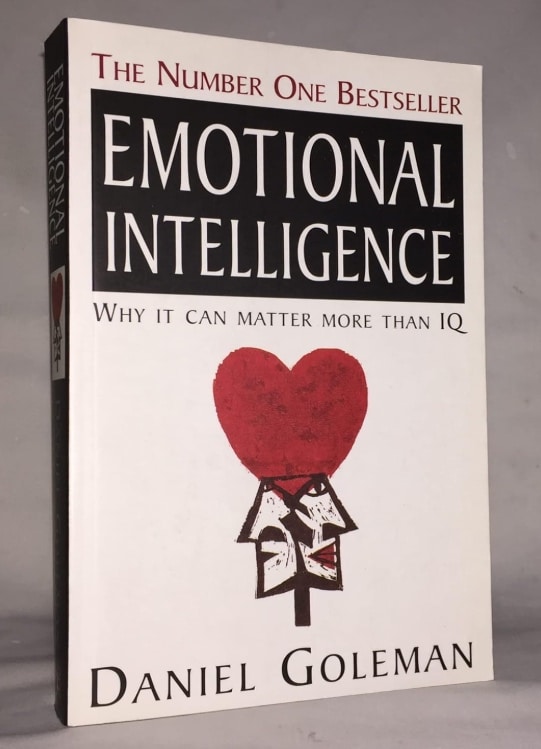
Daniel Goleman's book, "Emotional Intelligence," explores the crucial role that emotions play in our personal and professional lives. It introduces the concept of emotional intelligence (EQ) as a key factor in achieving success, often surpassing the importance of traditional IQ. EQ encompasses five core components:
Self-awareness:
Recognizing and understanding your own emotions and how they impact your thoughts and behavior.
Self-regulation:
Managing your emotions effectively, including handling stress, controlling impulses, and adapting to change.
Motivation:
Demonstrating self-motivation, initiative, and a drive to achieve goals.
Empathy:
Understanding and responding to the emotions of others, building rapport, and navigating social situations effectively.
Social skills:
Building and maintaining positive relationships, communicating effectively, and influencing others.
In the context of Hybrid Agile Project Management, particularly in traditional industries like oil and gas, where remote work and cross-functional teams are common, EQ can be a game-changer. Here's how:
Enhanced Communication and Collaboration:
EQ fosters clear communication, active listening, and mutual understanding, which are vital for geographically dispersed teams. It helps bridge communication gaps and build trust, even in virtual settings.
Improved Conflict Resolution:
EQ enables individuals to navigate disagreements and conflicts constructively. By understanding and respecting diverse perspectives, emotionally intelligent teams can find common ground and reach solutions effectively.
Increased Adaptability and Resilience:
Agile methodologies thrive on adaptability and flexibility. EQ helps individuals and teams embrace change, manage uncertainty, and bounce back from setbacks, which are essential qualities in dynamic project environments.
Stronger Leadership:
Emotionally intelligent leaders inspire and motivate their teams, even from a distance. They create a positive and supportive work environment, foster collaboration, and empower team members to perform at their best.
Greater Client Satisfaction:
By understanding and responding to client needs and emotions effectively, emotionally intelligent project managers build stronger relationships and deliver superior results. Incorporating EQ principles into your hybrid agile practices can lead to improved team performance, increased productivity, and greater success in your oil and gas projects. By focusing on the people aspects and developing emotional intelligence within your teams, you can create a more collaborative, adaptable, and ultimately, more successful work environment.
Free Monthly Project Management Clinic

We're excited to announce a new initiative to support your project management journey: a free monthly online Project Management Clinic!
These 75-minute sessions will be packed with valuable insights and practical tools to help you excel in your projects. Each clinic will feature:
- Expert Presentations: Learn about relevant and useful project management tools and concepts applicable across various methodologies.
- Q&A and Problem Solving: Get expert advice and support on your specific project challenges.
- Networking Opportunities: Connect with fellow project professionals and share experiences in our small group breakouts
Why attend?
- Boost your project management skills: Gain valuable knowledge and practical tips to improve your project outcomes.
- Solve your project challenges: Get expert guidance on your specific roadblocks.
- Stay ahead of the curve: Learn about the latest trends and best practices in project management.
- It's completely free!
First Session Tuesday 3rd December 1900 GMT (UK Time)
AI: What works for us!
Our first session on 3rd December will cover an Introduction to AI in Project Management where will share what works for us and the resources we use. There will also be an opportunity to share your own learnings and tips in smaller group breakout sessions.
Where: Online (Zoom link will be provided upon registration via meetup)
Who should attend?
This clinic is ideal for project managers/engineers, team leads, engineers, and anyone involved in managing projects of any size or complexity. However these will be especially useful for early career project professionals or those charged with responsibilities for coaching and training emerging leaders.
How to register:
Click here to reserve your spot:
We believe this clinic will be a valuable resource for you and your organization. We look forward to seeing you there! Don’t delay as places limited.
Best regards,
The Cranston Engineering Team
Check us out at www.cranstoneng.com
The Engineering Disciplines
The Engineering Disciplines- An Introduction
In this article we will cover the different specialist engineering disciplines, typical organizations, Engineering deliverables, Interface management and finally KANBAN

The Engineering Disciplines
The disciplines, as they are known, are the specialist engineering teams which include but are not limited to :
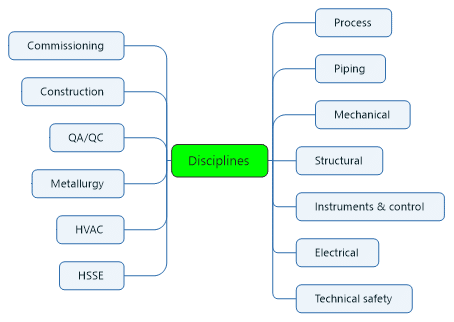
The list of disciplines above relates to Offshore Oil and Gas/New Energy however many of the specialist disciplines are also involved in many other industries with very similar work processes and deliverables.
As a aspiring or practicing Project Engineer/Manager or Engineering Manager you may come from a range of backgrounds including:
- A discipline engineer with several years of experience.
- Direct entry as a graduate.
- As a Project Engineer/Manager or Engineering Manager from another industry.
- As a subcontractor/supplier engineer.
Whilst you may have expertise in one of the above it is not possible to have expertise in them all. Link to Engineering Disciplines Online course
Discipline engineers normally progress from graduate engineer through various levels of increasing competence and responsibility up to Principal or Lead engineer. As a Project Engineer/Manger you will not be involved in the detailed engineering and calculations that the disciplines do but will have an important role in coordinating their efforts.
As an Engineering Manager you will be accountable for the resourcing of the engineering team, quality of work and ensuring compliance with appropriate internal and external standards.
As the Project Engineer/Manager you will need to have a higher-level view of the overall scope and be able to integrate the efforts of the disciplines. To do this you need to have a sufficient understanding of what each discipline does, their design processes and how they interface with each other.
As an Engineering Manager you will be responsible for the entire engineering team and therefore will require a comprehensive understanding of each discipline.
Tip: When joining a new project the first two documents that I obtain are the structural General Arrangements, GAs, of the facility and the Process Flow Diagrams, PFDs. The structural GA lets me see physically what the installation looks like and the location of the main modules, such as process, utilities, drilling, & accommodation. The PFDs show the facility process at a high level.
Typical Organisations
Typical engineering organograms are shown below for a dedicated project team structure and for a matrix team structure.
Project Organogram

Matrix Organogram

The Engineering Discipline Team
The engineering team will report to the Project Engineer/Project Manager concerning deliverables and scheduled dates. They will also report to the Engineering Manager on technical issues and issues of procedural compliance. The engineering manager is also normally responsible for resourcing the engineering team and up-manning/down-manning as project workload dictates.
Engineering Deliverables and Interfaces Management
The key to a successful project especially during the design phase is effective management of the engineering disciplines. There are a range of techniques available:
- Minutes of meetings.
- Action Logs.
- Deliverables schedules.
- Formal Interface management procedure.
- KANBAN.
Minutes of Meetings
Minutes of meetings with the engineering team are useful to record interfaces and actions in detail. On the downside they take significant time to prepare and update.
Action Logs
Action logs using spreadsheets will not normally provide as much detail as minutes of meeting but are much quicker to update and will allow all completed action history to be maintained but hidden from current view.
Deliverables schedules
Deliverables schedules are lists of what each discipline is required to produce and by when. They are normally part of the engineering plan. When sorted by due date they allow the Project engineer to identify any items that are forecasting late and to focus on resolving any issues associated with their completion. These issues can be technical, resource, priority etc.
Formal Interface Management procedure
Where there are significant complex interfaces, I recommend use of a formal interface procedure using your organisations approved system or generating one yourself.
Each identified interface will have an owner and agreed interface parties. The interface will be fully defined and will include who needs what information, from whom and by when. This normally goes through several iterations before all agree that the interface is complete. The keys to success with interfaces are a structured approach to interface definition, regular updates, and formal final sign off by all the interface parties and the Project engineer.
Sources of interfaces
The main sources of project interfaces are:
- Sub-contractors
- Package vendors
- Area based teams performing scope in different geographical locations.
Interface process
A typical interface process is listed below:
- Develop interface management plan and procedures.
- Identify key interfaces, define deliverables, responsibilities, and dates.
- Summarise interfaces in the Project Interface Management System and extracted registers and reports.
- Review Interface Register at regularly scheduled interface meetings.
- Monitor, Track, Expedite and Report on interface performance and progress.
Interface information
It is suggested that each interface sheet contains the following information:
- Interface Number
- Revision Number
- Revision Date
- Title
- Short Description
- Data Supplier
- Data Receiver
- Required Return Date
- Forecast Delivery Date
- Close-Out Date
- Status
- General Comments
A large project will require a dedicated interface manager/engineer however on smaller projects this will typically be carried out by the Project Engineer.
Engineering Documents Process
Engineering documents/drawings are issued in a rigorously controlled manner by the Document Control Function, (DCC). These departments have bespoke databases that track every document, to whom it was issued, when and at what revision. Although the exact coding for documents varies with each organization the following generic types apply.
Issued for review (IFR): Documents/drawings are issued for review and comment by engineers and subcontractors with comments collated by DCC and returned to the origination engineer to allow revision of the document.
Issued for design (IFD): This is where documents/drawings are sufficiently defined to allow other disciplines to carry out detailed engineering. An example to this is piping and instrument diagrams, (see process chapter),when issued IFD can then be used by piping to develop their detailed layouts.
Issued for Procurement (IFP): This revision allows issue to subcontractors by the procurement team and is usually very well defined, specific in content and unlikely to change.
Issued for construction (IFC): These are documents/drawings that can be included in the offshore or module site construction workpacks and used for reference whilst carrying out the offshore construction.
KANBAN
KANBAN is a visual system adapted from manufacturing for knowledge based work such as projects. The key principles are:
- To map the work process. I.e. engineering process, procurement process etc.
- Populate a visual KANBANboard with cards indicating deliverables etc
- As a team review this regularly, i.e. daily and resolve any pinch points at the daily meeting.
This can be highly effective and really gets the teams working together and supporting each other. I recommend the following book to allow you to get started with KANBAN Theory. Try it! It is very effective. KANBAN in 30 Days.T&J Bjorkholm; ISBN 978-1-78300-090-6.
I have personally implemented KANBAN on a number of projects and it reduces e-mail traffic, encourages immediate short problem solving conversations and improves the team spirit. Check out the following link to our Hybrid Agile Approach
Engineering Disciplines Summary
As a Project Engineer/Manager or Engineering Manager you will only be as good as your engineering team therefore it is incumbent on you to look after them well. What this means is being clear in your requirements, resolving issues and providing information in a concise and timely manner.
The key to managing and supporting the disciplines is communication. This means that you as either a Projects or Engineering Leader taking the time to filter the “noise”, collate and organise information and then output agreed actions and interfaces to the team in an easily usable format.
Link to Engineering Disciplines Online course and other courses
As always comments and feedback welcome. Click here to get in touch
For further resources on the Engineering disciplines follow links to:
The Institution of Mechanical Engineers.
The Rise of Hybrid Agile
What is Hybrid Agile
In simple terms Hybrid agile combines elements of both Agile and Waterfall project management methodologies. It’s a flexible approach that adapts to the unique needs of each project/business process.
Think of Hybrid Agile as a spectrum of ways of working from 100% Predictive waterfall on the left graduating towards fully agile on the right

Source: PMI Report 15th Annual Pulse of the Profession
Many of us have been brought up with traditional waterfall predictive project management and at times can find the rigid structure restrictive and limiting with lost opportunities for improvements in service to our clients. We are also aware of fully agile approaches developed and adopted mainly by software organizations which are not suited to large sequential traditional projects.
The answer, I suggest, is a bespoke blend of both Predictive and Agile to suit the specific project requirements. This article will outline the key features of Hybrid agile, my personal experience implementing over a period of 8 years plus steps to take to implement Hybrid Agile on your own projects and business processes.
Benefits of Hybrid Agile
The key benefits that we have across both projects and business processes are:
- Best of both worlds (Predictive and Agile)
- Reduced process cycle times
- Reduced costs
- Better team spirit
- More satisfied clients and associated repeat/increased business
My Hybrid Agile Journey
My journey started in 2016 when the then Project Director gave me a number of KANBAN textbooks and requested that I implement on the project which covered hook up and commissioning of a new build FPSO vessel for the UK North Sea.
As is common, this vessel had been built on a budget in a Korean yard and required a lot of things to be rectified/modified before going on station in UK West of Shetland.
We initially looked at the areas of the project with the most issues and started our Hybrid Agile with implementation of a physical KANBAN board on the procurement and fabrication processes. We then extended to engineering, subcontracts and close-out.
This was pre pandemic/remote working and KANBANs were run on large white boards with colored magnets and associated physical scope cards. It should be noted that this did not replace the traditional waterfall planning associated with Hook up and Commissioning but added a very flexible, visual tool to support the areas of project process where there were acknowledged issues mainly to do with excessive delivery times.
Over eight years techniques have been developed and refined with experience gained both in person in the UK and remote support projects in the US Gulf of Mexico.
Most recently for the last 4 years we have been remotely supporting and extended team in US using cloud-based systems delivering KANBAN for major construction projects and operations support and have evolved a recipe which works.
Hybrid Agile Business Process
The following figure illustrates the link between the rigid corporate procedures and the more flexible supporting Hybrid Agile techniques.

Figure 2: Source: Cranston Engineering RGU MSc Lecture
At the top we have the rigid fixed audited process procedures.
These procedures are supported by the actual detailed working processes which can be adjusted and iteratively improved by the teams.
Finally, these working processes are supported by cloud-based KANBAN boards for the daily management and reporting of the work.
Hybrid Agile Components
A successful Hybrid Agile Approach consists of the following components:
- A custom blend of the traditional client corporate project-specific procedures complemented by flexible hybrid agile working processes.
- Business Analytics techniques to identify and capture requirements, stakeholders, and working processes.
- A structured Cloud-Based Kanban System utilizing the best-in-class software “Trello” and its associated “Power Up” third-party software packages.
- Data Analytics structured cleansing and configuration of your data in preparation for potential future AI applications.
- Actively seeking and implementing incremental process improvements
- An emphasis on the importance of people and the associated “Soft Skills.”
- Ongoing team coaching in line with Sir John Whitmore’s “Coaching for Success Principles” to ensure consistency of approach and continual improvement.
Latest research
The newest Project management Institute research confirms the growing adoption of Hybrid project management frameworks that adoption has increased a staggering 57.5% over the last three years, from 20% in 2020 to 31.5% in 2023.

Figure 3:
Project management Institute (PMI) research has revealed that there is no single way to work “hybrid” (see Figure 4), but at its core, hybrid incorporates both predictive and agile approaches to provide the predictability, flexibility and agility that the project requires.
For this reason, project professionals should consider different factors, such as the nature of the problem, business constraints and organizational culture, when choosing the right approach for projects.
As the future of work changes, preferences for project management approaches are changing as well. PMI research shows that organizations have shifted toward flexible, fit-for-purpose project delivery practices.
Finally, this research shows that organizations can unlock above average project performance by providing resources that build employees’ capabilities, enabling them to adapt to different project and business circumstances, challenges and needs.
What are the enablers to Hybrid agile
The following Hybrid Agile enablers have been identified as having the greatest impact on Project performance tares
- Coaching and Mentoring of Project Professionals regarding planning and achieving professional development
- Training in new ways of working thereby expanding the practitioners personal PM toolkit
- Communities of practice to share knowledge and expertise
Impediments to Successful implementation
Over the years both within our clients and their customers we have encountered the following impediments:
- Reluctance amongst certain individuals to embrace change.
- Rigid corporate procedures especially w.r.t. to Agile/Hybrid agile.
Individual reluctance can be addressed in one-to-one coaching sessions sharing and reiterating how hybrid agile will make the persons work life easier and more productive
Regarding rigid corporate systems, this is changing as the uptake of Hybrid agile implementation and personnel with Hybrid certifications increases and positives are realized.
Links with Data Management
Hybrid Agile lends itself to the structured use of Data Analytics. By establishing a coherent data management process projects can leverage the value of clean organized data and the resulting valuable decision supporting management insights. It cannot be overemphasized of the importance clean coherent data as a precursor to the ever-increasing use of AI.
Considerations when Implementing Hybrid Agile
- Each client implementation is bespoke
- Implementation must support a live working process
- Full awareness and mitigation of change impact on team
- Providing full training/briefing on technique and principles
- Provide ongoing support to steady state operation
Although we have a general approach each implementation is bespoke to the requirements of the project or process:
As you cannot stop the work process/project and implement something new the hybrid agile techniques must be capable of being implemented on a live project. Probably the most important consideration is the impact on the team. Sensitively managing introduction and ongoing coaching is the key to success.
On our organizations implementations for clients everyone on the team from management. to documentation control/admin get a one-hour minimum hybrid agile briefing with emphasis on KANBAN theory and principles. This is part of the “hearts and minds” and to get the team on the same page.
Don’t rush an implementation and walk away as support will be required until steady state is achieved. PMI research suggest that 70% of the effort in an implementation will be on supporting and coaching the team.
Provide ongoing support using the following techniques
- Coaching
- Maintenance
- Date cleansing
- Retrospectives
The Future of Hybrid Agile
- From Teams to Enterprises
- From individual process to Value Streams
- From Project to Product Management
- Team Leadership to Executive Leadership
- Cross Fertilization between Industries
- Leverage of Data Analytics
- Incorporation of suitable AI
Lots of individual teams are now developing expertise with Hybrid agile approaches. These teams are now starting to implement hand offs and links to other processes.
I suggest a top-level strategic approach across the enterprise with the details sub processes developed by the individual teams.
Individual KANBANs can be standalone but will be of more value if the Value Stream mapping is carried out right across the enterprise. As people become familiar with process mapping at a team level and shaking out waste, it is not a huge step to value stream map across the enterprise.
Projects are usually of a relatively short duration i.e. A few years. Take for example an engineering company doing projects. Each project is stand alone with a start and a finish, but the product of the organization is delivery of projects. In addition to improving the project processes the overall product delivery can be treated as a process and Lean principles applied.
Leadership ! For Hybrid Agile to really work it is not enough for senior management to instruct it to happen . They must fully understand and embrace it themselves. Otherwise, it can become diluted and even wither.
Cross fertilization between departments projects, industries. By cherry picking elements from diverse sources, you can then put together a bespoke set of Project Management tools for a particular project and its project team.
Data Analytics is a growing field and using suitably qualified practitioners can add value to your data resulting in process efficiencies and valuable management insights.
Finally, Hybrid Agile when combined with a robust data management process will allow for easier more effective implementation of appropriate AI as and when it is developed and configured.
Suggested Steps towards Hybrid Agile Implementation
- Professional PM Qualifications APM/PMI.
- Short course in Business Analytics
- Acquire Theory/Fundamentals for KANBAN and SCRUM
- Assign experienced Hybrid agile practitioner to support initial implementations
- Identify areas of required improvement and build business case for implementation
- Form Diagonal slice with working KANBAN team circa 6 max
- Map actual working process “warts and all”
- Build KANBAN board using suitable cloud KANBAN software
- Configure and populate KANBAN board
- Establish regular synchronization meetings
- Establish regular incremental improvement retrospectives
- Automate report and analytics generation using available “Apps”
- Establish agreed Key Performance Indicators to drive improvements
- Look after and continue to support/coach the extended teams
Summary
Change is in the nature of project management with exciting things happening in the fields of Hybrid Agile, Data Analytics and Artificial Intelligence (HADA AI for short)
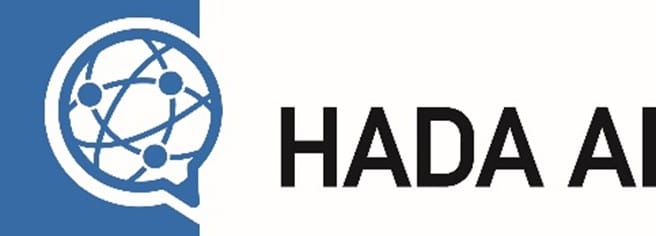
Hybrid agile provides a combination of high level corporate auditable procedures and agile
flexible next level team workflows linked to cloud-based KANBAN and SCRUM boards
Use of data analytics will reduce errors, improve efficiency and gain insights.
Regarding AI, It is here, Understand it, Get the skills or be left behind.
Project managers who stay at the forefront of the progression of emerging technologies and help drive AI adoption within their organizations will best position themselves for career success.
In closing this is a real opportunity to embrace and develop new approaches to the benefit of your projects and clients.
Resources
The following Tools and Resources are suggested to get you started on your Hybrid Agile Project Improvements
- Project Management Institute Hybrid Agile Micro Credential
- Project Management Institute Generative AI Overview for Project Managers
- Kanban in 30 Days: By Tomas Björkholm, Jannika Björkholm
- The Toyota Way: Jeffrey K Liker
- The Human Side of Agile: Gil Broza
- Business Analysis Techniques
- The Project Management Institite Project Management Institute | PMI
- Cranston Engineering Online Hybrid Agile short course. Contact info@cranstoneng.com for details
- Cranston Engineering Website Project Engineering Online Courses, Training & Coaching Oil & Gas (cranstoneng.com)
References
- PMI Report 15th Annual Pulse of the Profession
- Cranston Engineering Ltd to Robert Gordon University MSc Cohort Hybrid Agile Lecture
PMI Infinity. A Project Managers Copilot
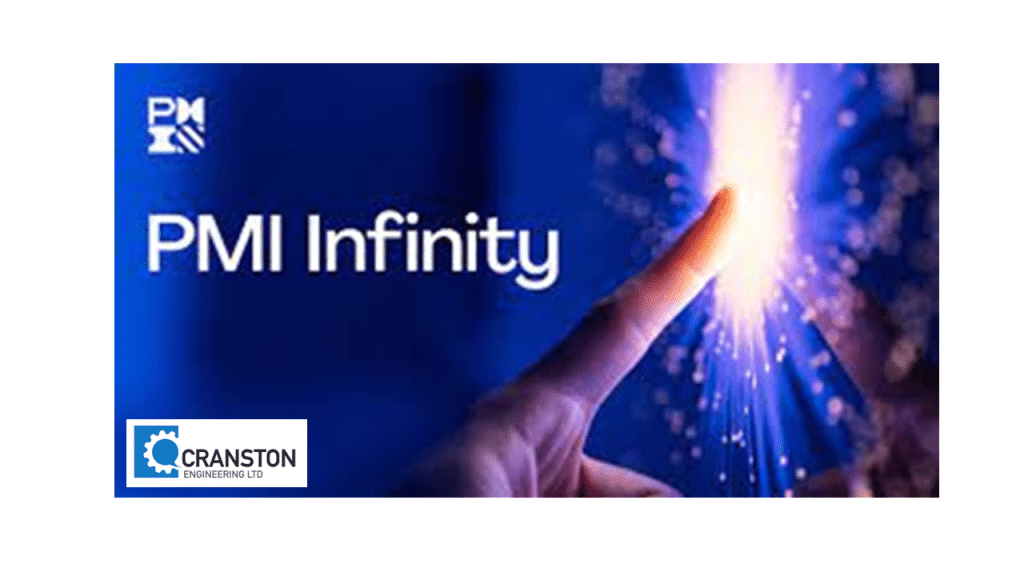
Just wanted to share a new Project Management AI tool, PMI Infinity, that I have been trialing for a month. I am initially very cautious especially w.r.t new AI and all the associated hype but am pleased to advise that my initial findings are that the Project Management Institutes Infinity Project Management resource is a useful tool for both developing and experienced Project Engineers/Project managers.
It is currently a Chat GPT 3.5 based resource that has been trained on the huge PMI resources including PMI standards Guides, Courses and its extensive library plus other external academic PM content. I was also pleased to find out that it is not limited to PMI resources and has access to the complete internet data as per GPT 3.5.
I have tried out prompts or a range of issues both “hard” and “soft” including:
- What are the advantages and disadvantages of Hybrid Agile
- How to manage stress and increase morale within a project team
- Provide a detailed WBS for a new motorway
- Give me an itinerary for a 10-day road trip Vancouver to Calgary
The system also includes guided experiences to introduce the newbie to preparing suitable prompts.
Further to a webinar by the PMI Head of Innovation Ranjith Nair yesterday we were advised that discussions are ongoing to allow other PM organizations to use the resource plus a soon to be implemented migration to Chat GPT4 Turbo which will significantly increase capabilities.
Finally, PMI infinity is available free to all PMI members worldwide. It should be noted that PMI membership is $139 annually which compares favorably to Chat GPT 4 general access which is currently $240/annum. Check out the Project Management Institute
Looking forward to more utilization of this tool as it develops and improves with the caution that you still need to sense check and validate AI output using experience and common sense.
What is Hybrid Agile?
The objective of this Blog is to explain the relatively new Project management techniques of Hybrid Agile and how they can potentially help you in managing your projects.
What is Hybrid Agile?
Hybrid agile is a blend of traditional Waterfall Project Management and Agile Project Management in the appropriate bespoke proportions for your projects.
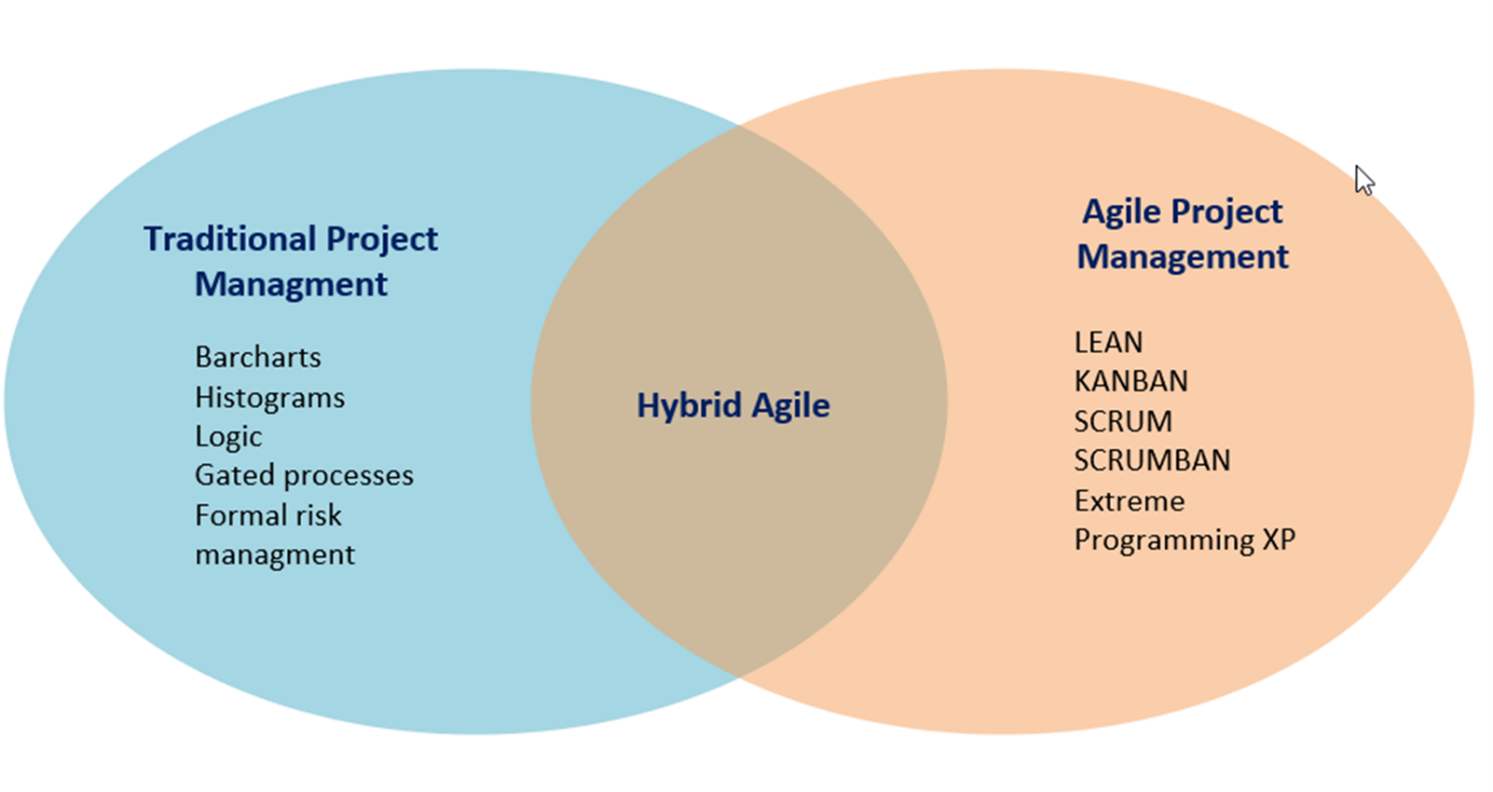
Traditional project management Follows the “waterfall” approach as shown above in the blue side of the diagram.
Agile Project Management comes from the “agile manifesto” developed circa 20 years ago by software experts. It now broadly means anything that adapts, evolves and provides incremental benefits as it proceeds.
These days the smart people use a bespoke blend of Agile and Waterfall methodologies to suit the project or process.
It may be heavily traditional, heavily agile or balanced between the two.
Lots of people and companies throw about the “agile working” words without knowing what it really means.
Why should I Go Hybrid Agile
You should consider going to hybrid agile where improvement in your process and delivery can deliver benefits. You need to do a business case to satisfy yourself and your management clients that there is value in the investment. Additionally, in a rapidly changing environment If you don’t implement you risk being left behind.
Typical Benefits Realized from Hybrid Agile
Please see the following lists of typical benefits realized by going the Hybrid Agile route.
- Best of both worlds
- Reduced process cycle times
- Reduced costs
- Better team spirit
- More satisfied clients
My Hybrid Agile Journey
My Hybrid agile journey started back in 2016 where the Project director gave me a bunch of KANBAN books one morning and requested that I implement for the project. I then Bought a white board and a whole lot of colored magnets.
The KANBAN Pilot Started with procurement and fabrication and then extended to engineering, subcontracts and close out. Over the following months we achieved good measurable successes.
Next was a program of smaller brownfield projects for existing UK North Sea offshore assets. Again, good measurable successes.
At that point stepped out to work as independent consultant and was invited to support a US Gulf of Mexico $14B project undergoing hook up and commissioning.
We are now currently providing remote support to a project team in Houston, and UK. This has resulted in the development of new tools /techniques and a Hybrid Agile course.
Business Processes supported.
The following list summarizes the business processes currently supported.
- Subcontracts
- Rentals
- Integrity Management (500+ scopes)
- Asset Maintenance
- QA Non-Conformances
- Plant Shutdowns
- Materials Disposition
- Contract Transition
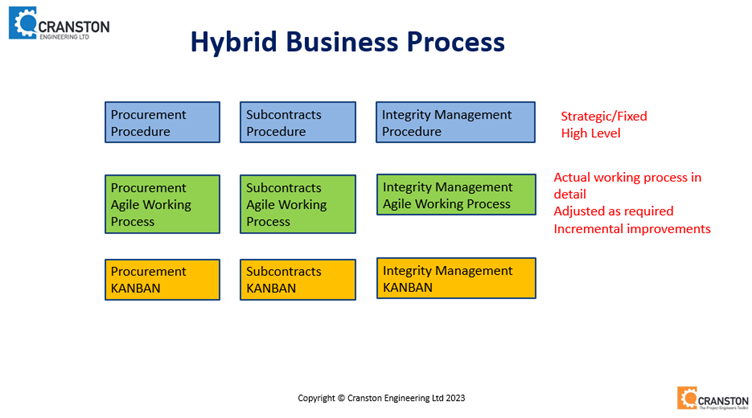
The above figure illustrates the Hybrid business approach.
At the top is the “Blue” strategic fixed high-level procedures for the program or project. These are purposely not too detailed to allow the implementation team flexibility in their working processes.
The “Green” working processes are the actual working processes, “warts and all” and are mapped and iteratively improved by the team whilst aligning with the “Blue” strategic processes. This gives the team flexibility to self-manage aspects of their processes.
At the bottom is “Yellow” the supporting KANBAN boards where the working process uses standard KANBAN techniques to manage the scopes.
Case Study: Integrity management
For our case study we will consider a program of circa 500 minor maintenance projects per year which were originally managed on a large excel spreadsheet.
The team experienced the following pain points resulting in stress and low efficiency.
- Multiple Non-Aligned Spreadsheets (COVID Hangover)
- No Visual Perspective
- E Mail inundation
- Missing/Lost Emails
- People developing individual approaches.
- Once weekly spreadsheet update
Post Implementation of a Hybrid Agile solution the team has realized the following benefits:
- Real Time data
- Visual communication (1000 times quicker)
- Everyone engaged.
- Less emails
- Team focused on same issue at same time.
- Team cohesion/team spirit
- Fewer meetings
- Estimated 2 hours saved per week per person (EMs)
- Hand off to reporting (Blue Cat)
- Hand off to Analytics (NAVE)
- Data driven insights to decision making.
- Continuous improvement retrospectives
We find that initial improvements can be seen in 2 to 6 weeks with significant improvements and Hybrid Agile process maturity within 4 to 6 months.
Next steps for a Mature Hybrid agile implementation
Continuous incremental improvement is the name of the game for Hybrid agile with the following now being implemented for the above case study.
- Data Analytics Approach
- Blue Cat/ Power BI Management dashboards
- Advanced Hybrid Agile Coaching
- Exploration of appropriate AI
Data Analytics
Clean data is vital to allow insights into the processes to be realized and to support decisions. By applying standard data cleansing techniques and coding data for easy analysis/manipulation a lot of value can be leveraged to assist in process pinch point identification and resolution.
Hybrid Agile Software Platforms
The main software system that we use is Trello, a cloud-based KANBAN system. This has been chosen as its feature rich and supported by a number of third party “Power ups” or Apps which increase the functionality. There are other software systems available which can be used in similar manner including Teams planner, Azure , Monday, Kanbanize etc.
One of the most powerful features of Trello is that it is a visual system with people estimated to assimilate visual information up to 1000 times faster than written text. This combined with sophisticated filtering and labelling capability allows mtg appropriate custom views to be shared with teams at the regular synchronization meetings .

Hybrid Agile Coaching
Hybrid agile implementations do not succeed based on a “teach and walk away” approach. It is important to continue to support and coach all team members to build their skills and to ensure consistency of approach.
Artificial Intelligence considerations
With the arrival of Artificial Intelligence, a Structured Hybrid Agile process using data analytics methods lends itself to the use of appropriate AI to find insights not easily visible and to support management decisions.
Hybrid Agile Process
The Hybrid agile process is summarized below.
- Position Statement
- Process mapping
- KANBAN Board
- Reporting
- Analytics
Position Statement
This is a structured approach to get all stakeholders to the same understanding and agreement on sequence of actions. Please see Position Statement
Process Mapping
The actual working process is mapped warts and all in order to get all parties to understand and agree on the whole process. This process is then used as a basis for continuous improvement.
KANBAN Board
A KANBAN board is then built based on the agreed working process and populates with the cards containing the individual work items.
Reporting
Reporting is provided at two levels.
A “ Power Up” called Blue Cat up is used to provide simple reporting. Configuration of this simple reporting can be taught in circa 1 hour.
More complex reporting is provided via hand of to Power BI which requires Power Bi skills.
Analytics
A further feature of Trello is An Analytics Power up with automates KANBAN analytics and provides insights in to process bottlenecks and issues which can then be used to prioritize work and process improvements
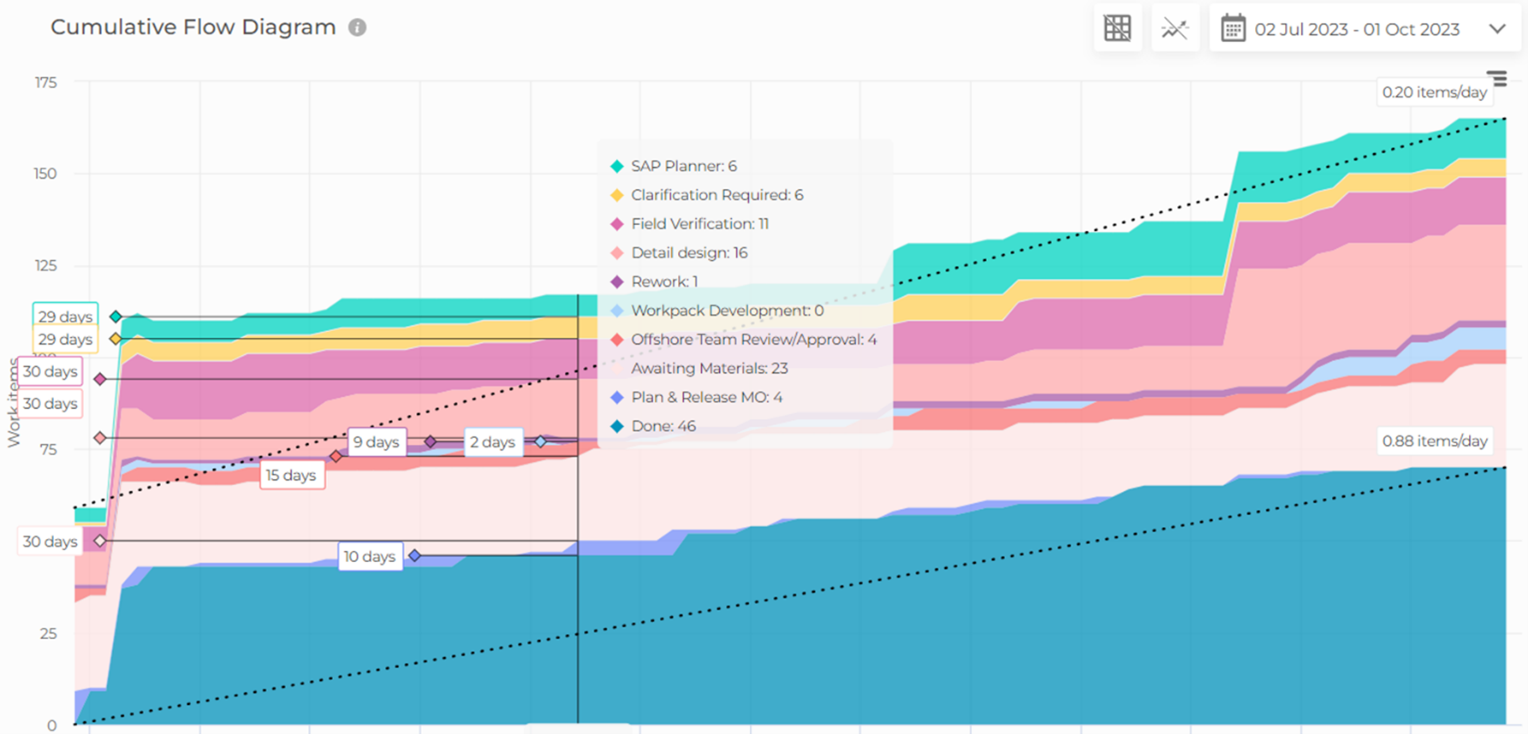
Cumulative Flow Diagram
The Cumulative Flow Diagram shows the amount of work in each process stage at a given time and can be used to identify emerging bottlenecks and to review process stability.
For more deatils on a sophisticated yet simple to use KANBAN Analytics software please go to Nave KANBAN Analytics
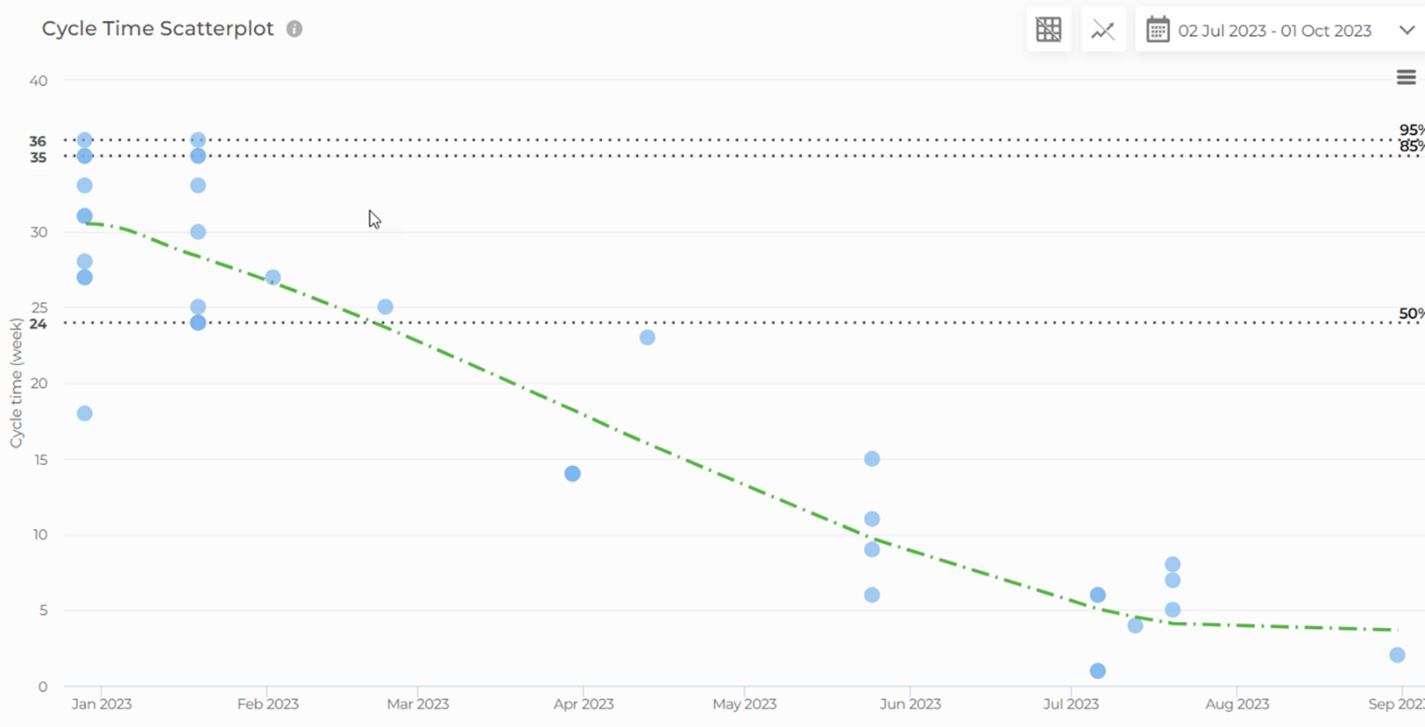
Cycle Time Scatter Plot
The cycle time scatter plot captures the cycle time for each scope in the selected parts of the process and more importantly a trend line on how cycle time is increasing or reducing.
Hybrid Agile Success factors
For hybrid agile to work there are several “Success factors to be considered.
- Project Management Training and experience
- Awareness of change impact on people
- Well developed “soft skills”
- Attendance at a Hybrid Agile “Super users” course
- A continuous improvement mindset
- Enthusiasm
What Does the future Look Like for Hybrid Agile
- From Teams to Enterprises
- From individual process to Value Streams
- From Project to Product Management
- Team Leadership to Executive Leadership
- Cross Fertilization between Industries/Geographies
We see Hybrid agile spreading from individual teams and projects to complete enterprises as experience is gained and the culture and mindsets are adopted.
We also see clients starting to complete value stream mapping across their processes when aligning with Hybrid agile. The KANBAN process also allows the enterprise to model its entire business of completing projects as a process.
To work the executive teams, need to fully engage with hybrid agile concepts and to get their “hands dirty” in order to fully understand the tools. And finally different locations from the same enterprise can share learnings and best practices vis appropriate forums.
Conclusion and next steps.
Hybrid agile delivers measurable project and program business improvements with result in lower costs, reduced duration , less team stress and more satisfied clients
If you are interested in finding out how Hybrid Agile can help your organization, please contact us for a no commitments initial discussion.
What a Project Engineer Does
What is a Project Engineer and what are their roles and responsibilities?
It is estimated that there are circa between 100,000 and 200,000 Project Engineers (PEs) in the worldwide Oil and Gas industry, so you are or will be part of a very large community. The term Project Engineer (PE) covers a multitude of areas and varying degrees of technical knowledge, project size and responsibilities, all having the common feature of accountability for the delivery of projects or part of a project

Project Engineers work for Oil & Gas operators, engineering contractors, equipment manufacturing subcontractors and maintenance companies. They have an essential role to play within technical project teams in ensuring that engineering/construction/maintenance projects are completed safely, within budget and in a timely manner.
A Project Engineer may be responsible for managing a project from thousands up to many millions of dollars. They may be part of a project management team responsible for parts of a larger project, or they may be responsible for managing a portfolio of smaller project scopes. The role of the Project Engineer can often be described as that of a liaison between the Project/Contract Manager and those within the technical disciplines relevant to the project. The Project Engineer is also often the primary point of contact for the client.
As a PE, it is standard for you to be responsible for successful delivery, and for managing scope, cost, schedule and risk. The greatest accolade a Project Engineer can receive is a simple two words: “You deliver!”
A Project Engineer Understands Why the Scope is Needed
Many projects run into problems because the scope is either poorly defined, poorly understood, or both. The Project Engineer needs to fully understand the scope and why it is needed so he/she can provide the optimum solution using the resources at his/her disposal. A structured technique for defining, agreeing and maintaining scope alignment is explained in the “The Position Statement.” See Project Engineer’s Toolkit course.
Generates the Big Picture
The Project Engineers needs to set the direction the team will proceed in and supports team members in reaching the goals. Sometimes the individual engineering disciplines/subcontractors are so focused on their individual scopes, that they may not appreciate the bigger picture. By taking time and discussing with both internal and external stakeholders, the Project Engineer can build the “big picture”, manage the interfaces, and communicate to the wider team.
Being able to simplify and communicate complex issues and scopes is a vital Project Engineering skill because it allows team members to understand the overall scope, and thus be better able to understand where their contribution fits.
Responsibility for Scope, Schedule, and Costs
In most projects, the Project Engineer is responsible for scope cost and schedule, although this can vary on the specific project.
- Scope is what we are going to do.
- Cost is normally the budget of the project.
- Scheduleis when we are going to do it.
Managing Change
Change is in the nature of projects, be it scope, schedule, cost or other influences. Badly managed change can result in cost and schedule overruns and an unhappy client. However properly managed change ensures that there are no surprises and that changes are agreed before implementation.
On many projects, the Project Engineer is responsible for managing change requests/variations and for submitting them to clients for approval. Some lucky Project Engineers may have a Change Coordinator to assist them with the workload associated with the changes. The job of Change Coordinator is an excellent position for new recruits/graduates as it exposes them to all areas of the project and reinforces the importance of change control from day one.
Poor management of change is a common reason for a “bad” project. Change is integral to all projects and properly identifying and managing change is an important skill for the Project Engineer.
A Project Engineer Coordinates Resources
Coordinates Engineering Resources
The Project Engineer will be responsible for coordinating engineers from various disciplines including Process, Structural, Piping, Instruments, and Electrical, to name but a few. I have specifically used the word “coordinate” because in many projects, the Discipline Engineers report to their discipline leads for work allocation and technical guidance, although their efforts are coordinated by the Project Engineer.
The simplest way to view coordination is that the Project Engineer represents the client’s interests while simultaneously being a customer for the Discipline Engineers.
Coordinates Vendors and Subcontractors
Almost all projects will require the services of subcontractors and vendors.
Subcontractors
Subcontractors are suppliers that enter into specific work contracts with the main contractor to work on major projects or for companies that need specific tasks to be completed within a limited period. Companies usually enter into subcontracting arrangements because they do not have the expertise in-house.
Vendors
Vendors are suppliers that sell identical or similar products or services to different customers as part of their regular operations. Examples include procurement of catalogue parts and components.
Project Engineers are often responsible for coordinating and integrating subcontractor and vendor services into the overall project delivery. Many PEs are employed by subcontractors and vendors responsible for their company’s contribution to the greater overall project.
Typical organisations
Project Managers and Project Engineers can exist at all levels in a project as illustrated below. Defined roles and responsibilities are more important than job titles.

One of the most important traits of a good Project Engineer is excellent leadership skills. However, do not worry if you do not currently rate yourself as a strong leader since leadership skills can be learned and practised. Most people already have some leadership skills, and in this book we will look at techniques to develop those skills.
Resolution of issues.
In projects, many issues are not black and white and will call for some project support to resolve. The Project Engineer will be able to facilitate resolution of multi-discipline and multi-company issues. Guidance, support, and coaching in resolution will normally be provided by the Project Manager or other more senior Project Engineers.
The key to resolution is to fully define the issues, communicate to all the required people, and work systematically to an agreed upon and documented solution.
Defusing issues
As your experience develops you will be able to anticipate problems and defuse them before they impact the project. To outsiders, some of the most successful Project Engineers seem to be calmly sailing along without any issues, but underneath the surface they are working hard to identify and prevent problems from building up. This should be your aspiration.
Making decisions
Often you have to facilitate a decision to progress a project scope, and you may have to do this based only on partial information. Depending on your project, you may work through an issue with the team, document it, and having the bigger picture, `make a recommendation to be ratified by your manager. All project decisions should be recorded in the project decision register including at a minimum, the decision, date of decision, decision parties, and any key document attachments. Making difficult decisions will develop good judgment; you might not always get it right, but when you don’t, you will certainly learn for the next time.
Client interface
The Project Engineer is normally the direct single point of contact with the client’s representative for the project or part of a project. This will require regular verbal and written communication. Your people management skills will be developed and tested as you work with clients ranging from pleasant, challenging but fair to downright rude. The key is to remain polite and professional at all times since you are the face of your organisation.
Approving Expenditure
As a Project Engineer you will normally be responsible for elements of the budget and for approving expenditure up to a certain authorised level. You will need to be able to challenge the contents of an estimate when required to ensure that both your organisation and your client are getting value for money.
Communication
When asked, “What are the three most important aspects of Project Engineering?, my answer is: communication, communication, communication. You cannot over communicate. In the fast-moving pace of a project, miscommunication means errors, schedule slippage, and cost increases.
By good communication, I do not mean endless e-mail trails and turgid texts, but rather simple, concise communication that provides the right information in the right format to the right people. People are busy, so time spent on producing concise and accurate information will get results.
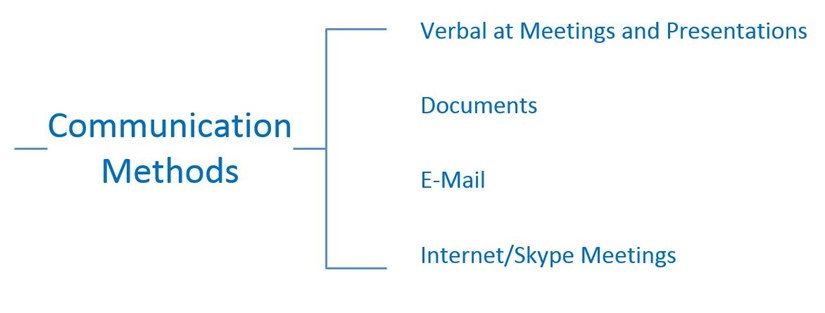
Less is more
When people are busy and swamped with data, take time to distil your message to the relevant points and actions and send only to the required people. This allows for more information to be received. Less is indeed more.
A Project Engineer will not normally complete the detailed engineering deliverables, but will be responsible for coordinating and managing the efforts of the technical disciplines and other specialists. To do this effectively you will have to develop and enhance your people skills. You will not need to get involved in every last detail and instead will sift out the important items from the “chaotic noise” to assist the team in delivering.
You need to be delivery-focused and able to self-manage. To be able to lead and manage a team, you first have to be able to manage yourself.
For details of our courses pls follow link
Typical Qualifications
There are three main routes for Project Engineer entry:
- Academic
- Project Management.
- Experience-Based.
Qualifications
Although the education and training possessed by Project Engineers varies by field, most hold a degree in engineering, construction management, or business management. Some Project Engineers also choose to earn a bachelor’s degree or a Master’s degree in Project Management. There are many excellent Project Engineers who had minimal qualifications but came up through the ranks.
Project engineering/management professional qualifications
Within Project Engineering/Management, there are several International Project Management organisations that are worth considering joining to gain certifications by demonstrating experiences and passing exams. These certifications provide common Project Management language and industry-accepted levels of competency.
Project management organisations include:
- Project Management Institute pmi.org.
- Association for Project Management apm.org.uk.
- International Project Management Association ipma.world.
Your employer may already have corporate membership with one of these organisations.
Personal attributes
Project Engineers need to have to have something more than just intelligence and training. They need to have the right personal attributes, which includes:
- Good problem-solving skills.
- Logical structured thinking.
- Dogmatic
- Good people skills.
- Being cool under pressure.
- And above all, a determination to get the job done.
Summary
As you have now seen, Project Engineers do a lot and are normally very busy people. If you like a multifaceted challenge, then Project Engineering may be right for you. Armed with the basic toolkit in this book, you will be better able to face the numerous challenges that are part of a Project Engineer’s daily work life. As your experience develops, you will be able to add additional tools and techniques to your toolkit.
By continuously putting yourself slightly out of your comfort zone, you will develop in Project Engineering/Management skills. Over the years, I have worked with many Discipline Engineers who have made the move into project management. The majority of them like the additional breadth, challenges, and increased satisfaction, and do not wish to return to their disciplines.
The most important attribute for a budding PE is a positive delivery-focused “can do” attitude.
Some say that “Project Engineers oil the wheels of a project.”
I personally like to think that Project Engineers do ”whatever needs to be done for the project to succeed.”
The Position Statement
How to scope an Issue or Part of a Project
Many projects can become confused and muddled, especially those with urgent scopes, rapidly evolving definitions and little to no control. This adds easily avoidable costs, delays, and stress to the project itself and the project team. The following Position Statement methodology is a proven, structured method of controlling the workscope and coordinating the activities of both the internal team and wider stakeholders

Objective of the Position Statement
In my experiences, many urgent and fast-track scopes are typified in long e-mail chains that are distributed to a wide audience in which key points and actions are unclear and buried in the text, and meetings are often too free-flowing with inadequate minutes taken.
The objective of the Position Statement is to provide clear project status that allows efficient and effective coordination of all stakeholders.
Initial Generation of the Position Statement
As the Project Engineer, it is incumbent on you to clarify and maintain the scope definition. Start by collating all the available information relating to the scope, such as e-mails, reports, meeting minutes, discussions with stakeholders, and so on. Review the input information and generate a draft document of your understanding of the
- Problem definition.
- Scope requirements.
- Schedule
- Internal and external stakeholders
- Next steps and actions.
Armed with this first draft, you will then review it with your internal project team. Figure 10.1 shows the iterative process of generation and update.

You now have an internal baseline document that you can review with the entire internal team, which will provide additional information and clarifications. At the end of this review, your internal team should have achieved consensus on the issues, scope definition, and next actions. The next step is to widen out the consensus of the project team to the external stakeholders.
This step involves reviewing the position statement and scope with external stakeholders, who might include client, subcontractors, and certifying authorities. At the end of this review, you should have gained accurate information on the issue and the proposed scope in a concise format. During face-to-face meetings or conference calls, walk the external stakeholders through the position statement to obtain their input and clarification. At the end of this stage, all the external and internal stakeholders should be on the same page regarding project scope and next actions.
Tip: Remember the team and stakeholders are busy people who do not have time to wade through long e-mail chains and potentially misinterpreted requirements.
Final Document
Further iteration
The position statement should have a date and revision at each issue. For ease and speed of assimilation, I suggest that changes from the previous versions are highlighted in a different colour.
On very urgent and fast-moving scopes, it would not be unreasonable to update the position statement daily, reducing frequency as the scope definition settles down
Benefits of a position statement
I have been using the position statement methodology for years and have coached many Project Engineers on its uses as an effective and time-saving tool. The position statement:
- Provides a clear unambiguous scope baseline at a point in time.
- Can be used as the basis of a more detailed scope document.
- Can be used as the basis for formal change control.
- Can be revised as scope changes.
- Assists in managing challenging clients.
Duration to complete position statement
The preparation of a position statement is an investment that will save time and reduce potential confusion, especially from those further from the centre. Typically, once input information has been reviewed, the position statement can be completed within an hour. As Project Engineer, you must perform the information review legwork for the entire team.
Typical sections
Typical sections of a position statement are shown below, although I recommend you modify them to suit your particular scope:
- Background on the issue.
- Work completed to-date.
- Identified solutions.
- Issues requiring further discussion.
- Single point contacts.
- Next steps.
Using a position statement brings all the stakeholders to the same place. It is relatively quick and easy to do, and it reduces stress on the organisation as a whole. Try it with your next scope!
“Sometimes when co-ordinating stakeholders, it feels like you are trying to herd cats.”
For further information on Position Statements and Work Statements please utilise the vast resources at the Project Management Institute




